I’ve been to Europe several times, but each time overlooked Poland’s capital, Warsaw. That was my first big mistake.
The second mistake was only spending 3 and a half days there.
I wish I had allowed more.
As someone who loves exploring new places, I can confidently say that Warsaw is a gem worth discovering, especially during the balmy summer months. With its temperate days, and laid-back youthful vibe, Warsaw is an underrated haven for foodies and culture enthusiasts alike.
In addition to its natural beauty, Warsaw is a city steeped in history. As you wander through its streets, you'll come across countless landmarks, museums, and memorials that tell the story of its past - from the Royal Castle, a stunning example of Baroque architecture, to the sobering history of the Warsaw Ghetto at the POLIN Museum of the History of Polish Jews.
Warsaw's tumultuous history is complex and engrossing, and delving into it will give you a deeper understanding and better appreciation of this resilient city and the Polish people.
It’s possible to cover the highlights in a 3-day whirlwind trip (like I did). But if you give yourself 5 days or more, you can delve further into the city’s past, connect to the present, and then discover a hidden side of Warsaw that most people don’t know exists.
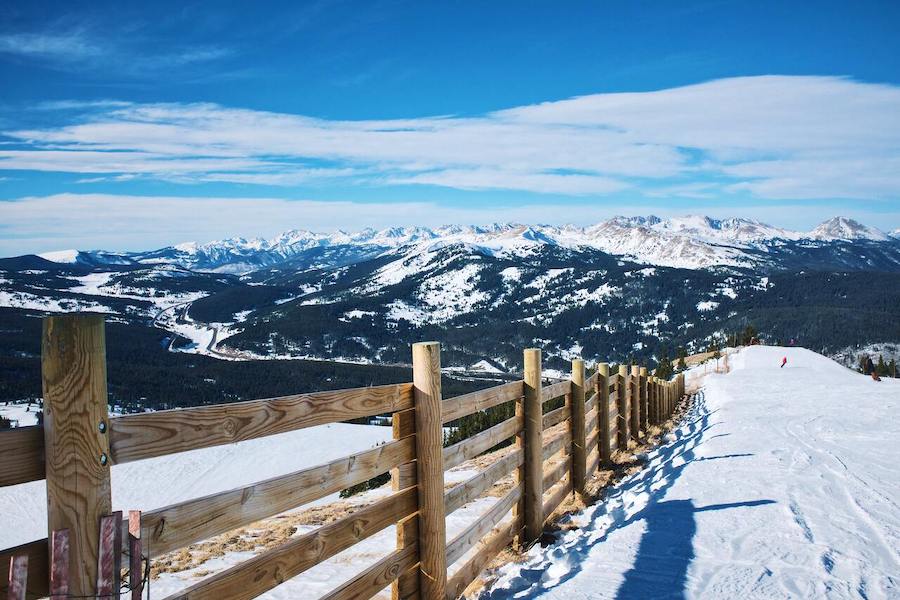
Essential reading: If your trip to Warsaw will be part of a larger trip around Europe, check out my essential guide on how to plan a trip to Europe.
Tip: Warsaw’s reputation as a tourist hotspot is growing, after winning the “Best European destination 2023” award. One of the most compelling factors is that it’s much safer than other European capitals.

How To Save Money in Warsaw
Located in the heart of eastern Europe, Warsaw benefits from a lower cost of living compared to major western European cities in like Paris, Amsterdam and Rome. As a traveller, this translates to your money stretching further. But there are still plenty of ways to save.

Use Public Transport
Trains and buses are run by the Public Transport Authority (ZTM), which issue tourist-friendly tickets for 24 hours, weekends and 3 days, as well as single-trip fares. The cheapest ticket is valid for 20 minutes (not valid on L regional buses), and only costs 3.40 PLN (US$0.79). Tickets can be purchased at Passenger Service Points, new trams, most buses, automated ticket machines, and several mobile apps.
Although I used public buses a few times, since I had a tightly-packed itinerary, I primarily used taxis and rideshares, which weren’t too expensive.
Warsaw Pass
If you’re going to go museum hopping like me, this is the easiest way to save money. With free access to over 20 top-tier museums and attractions for as little as 149 PLN (US$34.90), it’s a real bargain. Timed passes are available for 24, 48 or 72 hours, and prices increase for longer periods.

Getting Around Warsaw
Walking. Warsaw is a super walkable city. The majority of major attractions are spread around the city centre core (about 5km in diameter), although others are spread over a longer distance (from Palace at Wilanów to the POLIN Museum is 12.6 kms). I easily racked up over 15,000 steps daily on my Galaxy Watch, so wear comfortable walking shoes and socks (these are my favourite socks).
Public transport options like trams, buses and trains cover most of the city and tend to run on time, although the frequency isn’t as high as in larger European cities. Fortunately, severe traffic jams aren’t too common, and I was never stuck waiting for a bus for too long. The city’s official public transport app is called Jakdojade (iOS, Android), although I used Citymapper to find the nearest public transport station and calculate the fastest route.
Taxis & Rideshare are relatively inexpensive and can be faster than the train or bus, especially for shorter distances. The most popular e-hailing apps are: Uber, Bolt, Free Now, and SixtRide.
There’s no shortage of e-scooter options in Warsaw. These will suffice over short distances and can be a lot of fun. If you want to feel the breeze between your knees, the most popular options are: Lime, Bolt, Tier, and Dott.
Note: The Vistula Boulevards along the Vistula River is a safe and gorgeous place to ride an e-scooter any time of the day.
Bike sharing is an environmentally-friendly option, with many bike paths around Warsaw and safer road conditions than most major cities. Leading providers are: Veturilo (more details), Acro Bike, Nextbike (see news), and LimeBike.
Driving. Compared to other European cities, Warsaw is very drivable, and for short-term visitors, renting a car is more affordable. Getting around town is easy, but keep in mind parking costs. If you’ve got 4 or more in your travel group, then driving can work out cost-effective, especially if you’re trying to cram a lot of sightseeing in just a few days. A traditional car rental agency is a better option, as most local car-sharing platforms are only available in Polish. The easiest local platforms are the oddly-named Panek and Traficar.
Getting to (and from) Warsaw Chopin Airport (WAW) is super easy via bus. 5 express public bus routes are available, with 2 starting (or finishing) at the city centre (Bus 175, 188).
Bus stops are easy to find, with clear signage and automated ticket machines. The bus stop near the city centre was only a 2-minute walk from the hotel I stayed in - ibis budget Warszawa Centrum.

Essential Tours in Warsaw for a First-Time Visitor
Polish Vodka Tasting (Muzeum Polskiej Wódki)
Embark on a 1.5-hour boozy adventure with the Polish Vodka museum tour and tasting. Deep inside a renovated 1800s vodka factory complex, prepare to raise your spirits (and glasses) while you learn about Poland's rich vodka history, from its origins to modern-day distillation techniques. The tour guides are as witty as they are knowledgeable, adding a splash of humour to the experience. So, put on your "sipping" shoes and prepare for a tipsy trip that's sure to leave you "spiritually" enlightened. Na zdrowie!
Vistula River Cruise
Float your cares away on the Vistula River Cruise in central Warsaw. Grab your sunglasses and hop on board for a 1-hour scenic ride along the city's primary waterway. Marvel at the picturesque views of Warsaw's bridges, beaches, and historical landmarks while sipping on a refreshing drink from the onboard bar (tea, coffee and apples are included in the price). The laid-back atmosphere and gentle river breeze make it a perfect rest for your feet on a busy day of touring.
There are several operators to choose from, but I went with PO Wisle, who offer more intimate-sized ships with room for 12 and depart from this jetty. Check their website for the latest seasonal schedules.
Tip: Due to limited capacity, it’s best to book online in advance.
Food Tour and Cooking Class
Polish food is definitely worth writing home about. Get immersed in the local cuisine with this Polish Dumpling cooking class and vegan food tour.
Pub Crawl
One of my favourite way to meet new friends while travelling is a pub crawl, and Warsaw is no different. Everyone is more jovial after a couple of drinks. Plus, an expert guide shows you around the best nightlife spots in town to avoid wasting your time at places that aren’t buzzing. This tour has operated since 2011 and includes free shots and each venue, plus 1 hour of unlimited beer, wine and mixed drinks.
More
Want even more tour options? Check out these popular Warsaw walking tours on Withlocals, GetYourGuide, and Viator.
Essential Things To Do in Warsaw for a First-Time Visitor
Warsaw has so much to do it can be a little intimidating when comparing options. So I’ve included my hand-picked favourites, which are all within walking distance (or a quick bus) from the city centre (except the last one).
POLIN Museum of the History of Polish Jews
Quite possibly one of the best-designed museums I’ve ever visited anywhere in the world. And I’ve been to a lot. Opened in October 2014 and dedicated to the history of Polish Jews, each of the interactive exhibits is extremely engaging and thought-provoking. Combining the last 1000 years of history with cutting-edge multimedia, this museum shares a treasure trove of knowledge and culture in a balanced approach.
While most exhibits are family-friendly, be aware that exhibits covering the WWII Holocaust (gallery #7) may be intense and disturbing for some visitors. However, I firmly believe this should be an essential part of every visitor’s experience in Warsaw. We need to learn the lessons from history to avoid making the same mistakes again.
This place is huge, featuring 8 galleries covering over 4,000 m2. Allow at least 3 hours to do it justice. And make sure you listen to the audio guides to get the most out of your visit.

Warsaw Uprising Museum
This museum and memorial is a poignant tribute to the heroic spirit of the Polish people during the historic Warsaw Uprising of 1944. Explore the museum's exhibits that showcase the courage, resilience, and sacrifices of the uprising's participants. From immersive displays that include a replica B-24 bomber to personal testimonies, the museum offers a powerful and emotional experience that will leave you in awe. Check the official website for seasonal opening hours.
Tip: The audio guide can only be used inside the museum, however, you can access this free online audio guide on your phone for external exhibits surrounding the museum.
Łazienki Park
Covering 76 hectares of Warsaw’s city centre, this Baroque-style park was originally designed in the 17th century and transformed in the 18th century by Poland's last monarch, Stanislaus II Augustus, before being designated as a public park in 1918. Filled with scenic pathways, towering leafy trees, tranquil lakes and manicured gardens, this park is the perfect spot for a leisurely picnic or a peaceful afternoon escape from the city's bustle. Don’t miss the iconic Palace on the Isle, the summer residence of King Stanislaw August.
The Royal Castle
Step into a world of royal grandeur and regal charm. Built in the 14th century, the Royal Castle witnessed centuries of ceremonies, political intrigue, and epic battles, before being destroyed in World War II and reconstructed in the 1970s. Today, it stands proud as a UNESCO World Heritage site and a top tourist attraction. Explore the opulent interiors, marvel at the vast artwork collection, and soak in the stories of kings and queens that echo through its halls.
The highlight is a red and gold throne room, adorned with rows of ornate silver crowned eagles, the symbol of Poland. These had been removed under communist rule during the Cold War, as the Soviets shunned anything related to royalty, but reinstated in 1989.
Tip: Pick up the self-paced audio guide (free, with the “The Royal Route” ticket) to get knee-deep in one of Poland’s most iconic symbols of national pride.
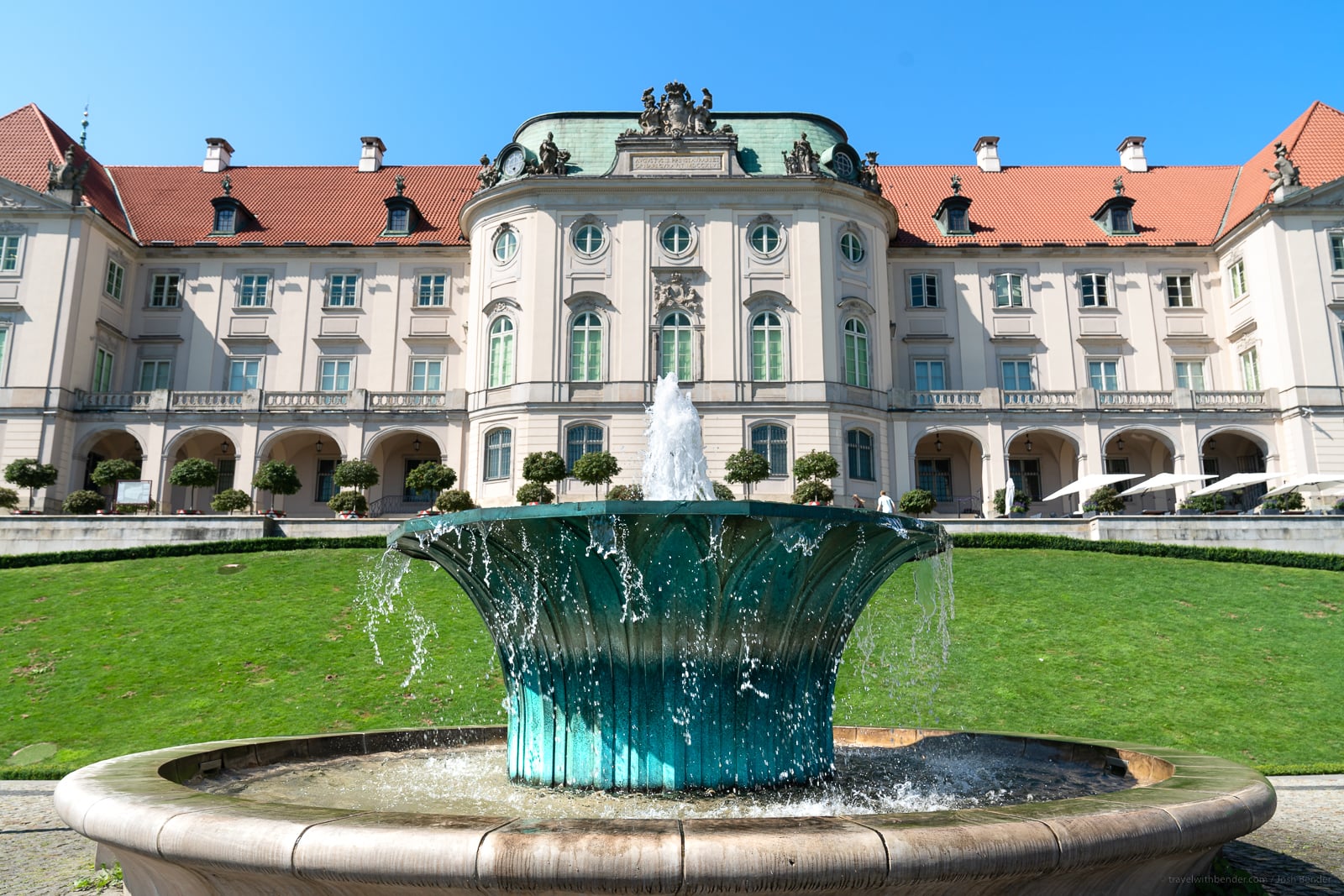
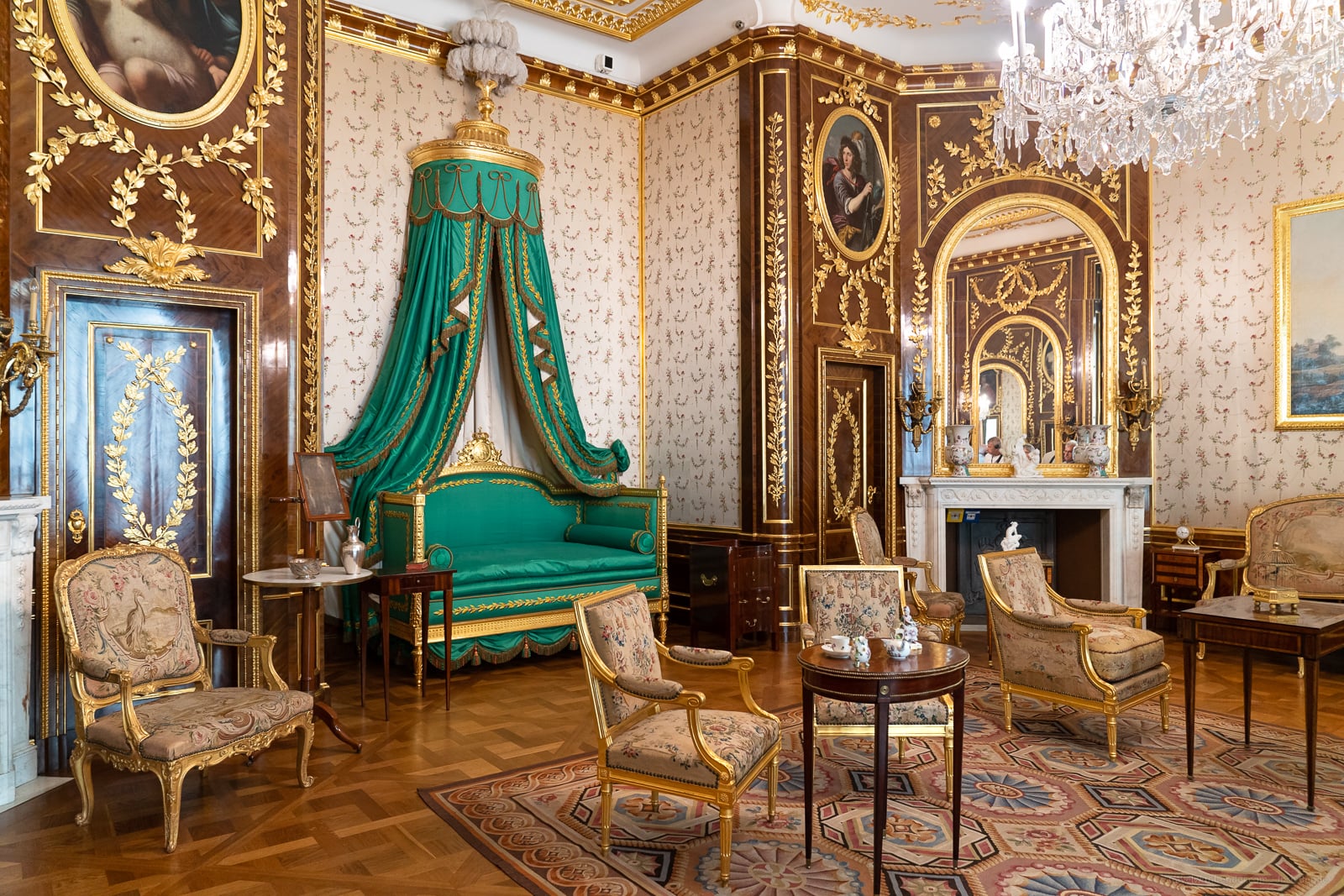
Warsaw Royal Castle Gardens
While gardens have been part of the Royal Castle complex since medieval times, the current form, inspired by French Baroque gardens, took shape in the 17th century. Featuring manicured hedges arranged into a labyrinth, classical sculptures and majestic fountains, the tiered landscape offers sweeping views of the city and river. Sadly, the gardens were destroyed during World War II. However, a reconstruction effort followed and found its completion in May 2019 when the gardens fully re-opened to the public.
Tip: The gardens are free for all visitors. I recommend entering from the gates on the east side, near the river and walking your way up. Then continue exploring The Royal Castle interiors.
Castle Square (Plac Zamkowy)
This is in the heart of Warsaw’s Old Town, in front of The Royal Castle. The square has a rich history, having served as the site of royal coronations and military parades throughout the centuries. Today, it’s a picturesque plaza surrounded by outdoor cafes and Baroque architecture, with the crowning glory, a tall column topped with a statue of Polish King, Sigismund III.
Tip: For the best view of the square and Old Town, check out this observation deck.

Old Town Market Square
Originally built in the 13thcentury, the square was destroyed during World War II and painstakingly reconstructed. Today, visitors can soak up the history and culture of Warsaw as they wander the quaint cobblestone streets, browse local vendors selling handmade crafts and souvenirs, and taste authentic Polish cuisine.
The square’s centrepiece is an unmissable mermaid statue (locally called “Syrenka”) that dates back to 1855. The original statue was replaced with a new one in 2008, with the original on display at the nearby Museum of Warsaw). This is of special cultural and political significance as the sword-wielding mermaid is protecting Warsaw from invasion (again).
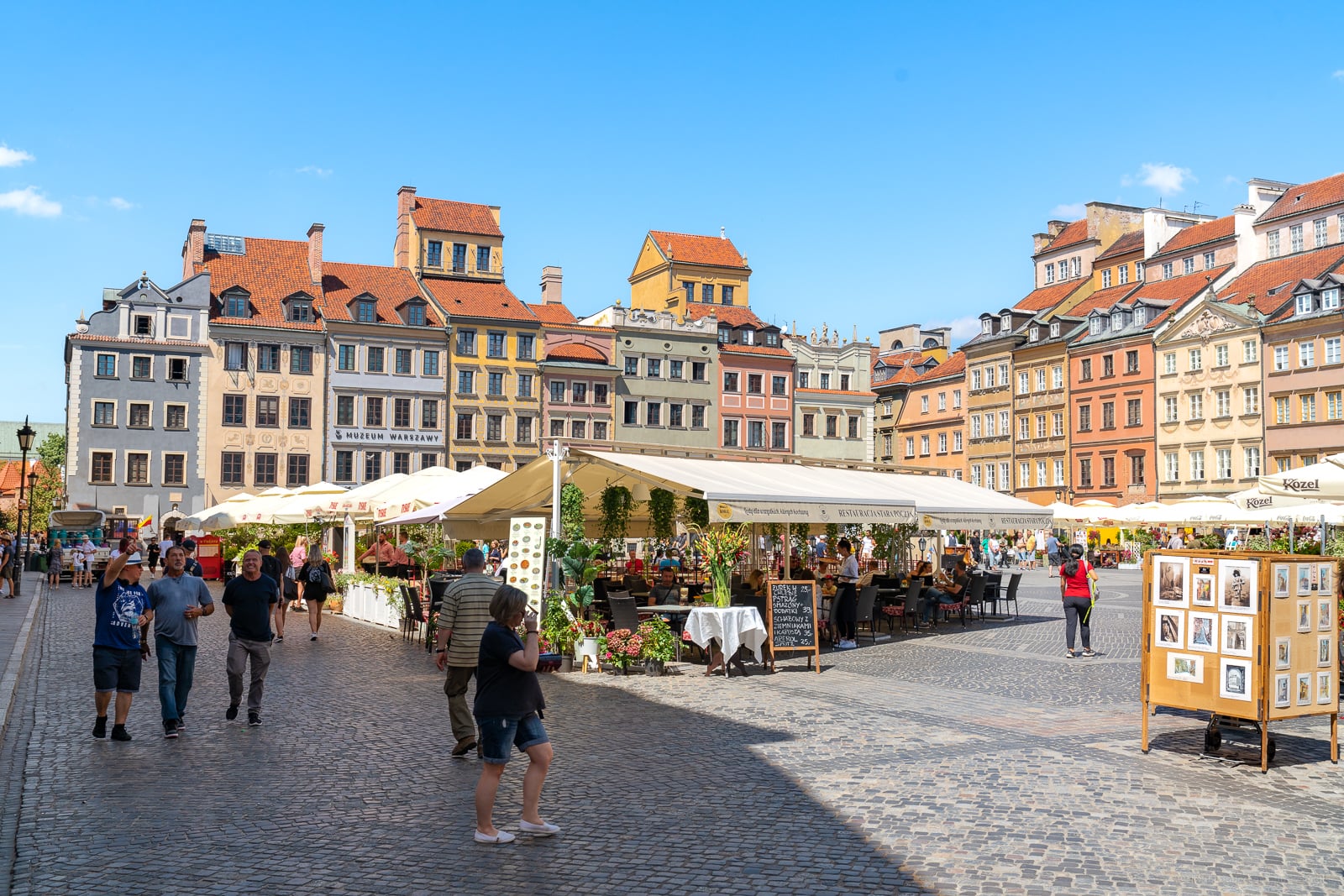
Warsaw Barbican
This fearsome defensive wall built in the 16th century served as a line of defence against invading forces, although it was only used once in a conflict in 1656 when recapturing the city from the invading Swedes. Despite being heavily damaged during World War II, the Barbican was restored to its former glory using bricks from demolished historic buildings in Nysa and Wrocław and is now a popular tourist attraction.
Vistula Boulevards
Originally built in the 19thcentury, this scenic promenade stretches for several kilometres along the Vistula River, and is lined with parks, cafes, and cultural attractions. The best way to enjoy this public space is to walk in the late afternoon or grab a rental bicycle or e-scooter in the summer.
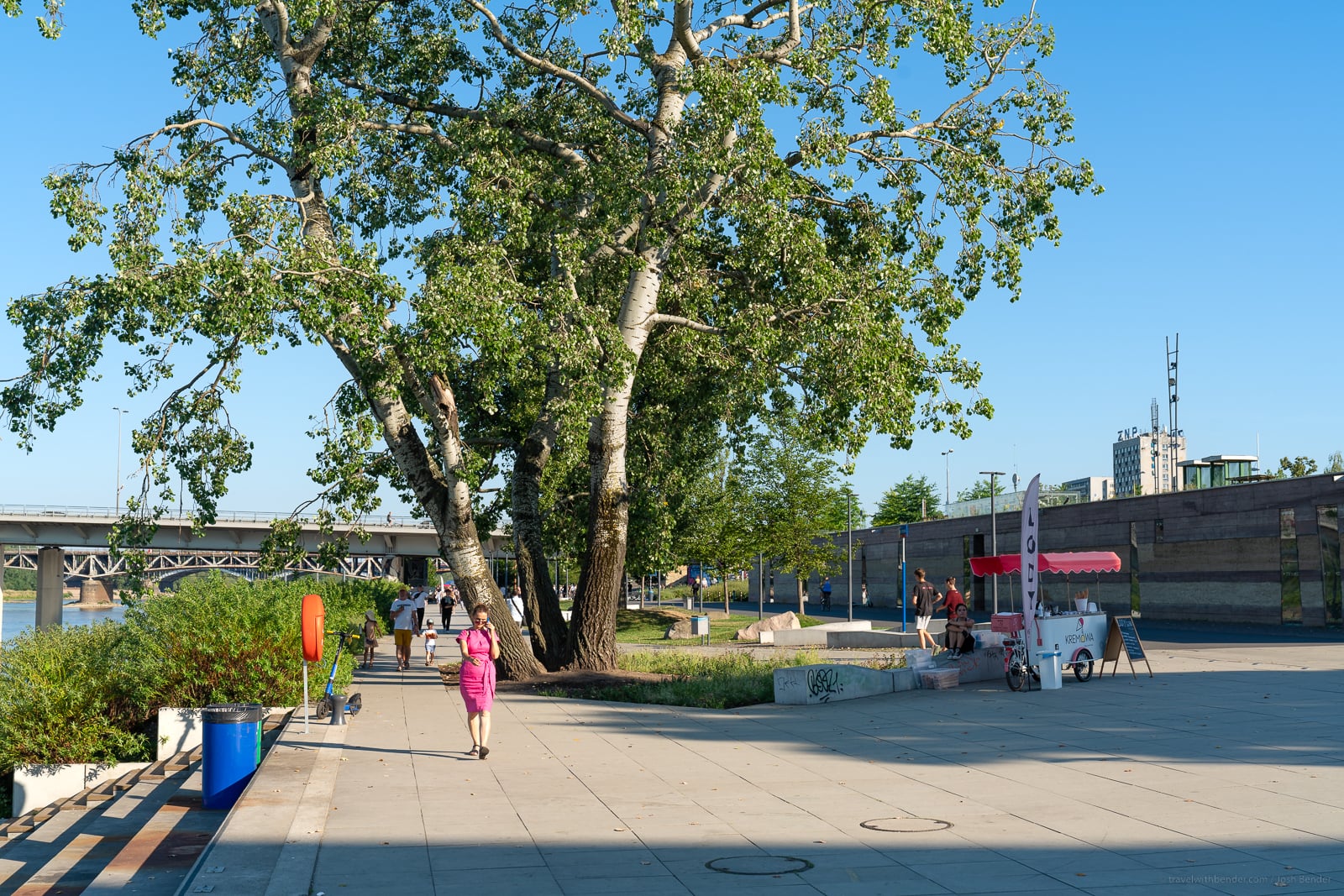
Multimedia Fountain Park
This state-of-the-art fountain system comprising 367 water jets, features a variety of shows that combine stunning choreographed water features with synchronized music and light displays. Opened in 2011, the fountain park was designed to celebrate the city's 200thanniversary of the adoption of the Constitution of May 3rd 1791.
Copernicus Science Centre
With over 450 interactive exhibits, this state-of-the-art centre is designed to spark curiosity and encourage learning through fun, interactive experiences. Named after the famous Polish astronomer Nicolaus Copernicus, the centre was opened in 2010 and quickly became a popular destination for tourists and locals alike. From exploring the mysteries of the human brain to discovering the wonders of outer space, there's something for everyone.

Saxon Garden
This tranquil oasis in the heart of Warsaw provides visitors with a peaceful retreat from the bustling city streets. Founded in the 17thcentury, the garden is one of the oldest public parks in Poland and home to Baroque statues and several monuments, including the Tomb of the Unknown Soldier and the Saxon Palace.
Nocny Market (Night Market)
Set on the platform of a decommissioned train station (Warszawa Główna), the night market is open between Friday and Sunday (and Thursday during summer). The market is a popular destination for foodies and culture lovers alike, with a diverse array of food stalls serving up everything from traditional Polish pierogi to international street food. Founded in 2016, Nocny Market has quickly become a staple of Warsaw's nightlife scene, with live music, art installations, and other cultural events taking place regularly throughout the season.
Suntago Park of Poland
Suntago Park of Poland opened in February 2020 and is one of the largest waterparks in Europe. Situated 50 kilometres southwest Warsaw, Suntago offers visitors a fun way to beat the summer heat. This waterpark boasts a wide variety of water attractions, including water slides, wave pools, and lazy rivers. Many areas are indoors, which offer consistent temperatures all year round. While kids will have a ball, over 18s can relax in an adult-only area upstairs which features 10 themed saunas, spa services, and more. I was pleasantly surprised to find the food quality and variety at the restaurants were very impressive, with reasonable prices too. Plus, vegetarian/vegan options were available too.
Tip: The easiest way to reach the waterpark is via a 2-way bus which can be booked through their official website. This is the best bus pickup location, just a couple blocks from the Palace of Culture and Science.
Tip: Lockers are included for free with an entry ticket, so you can securely store your valuables and clothing.
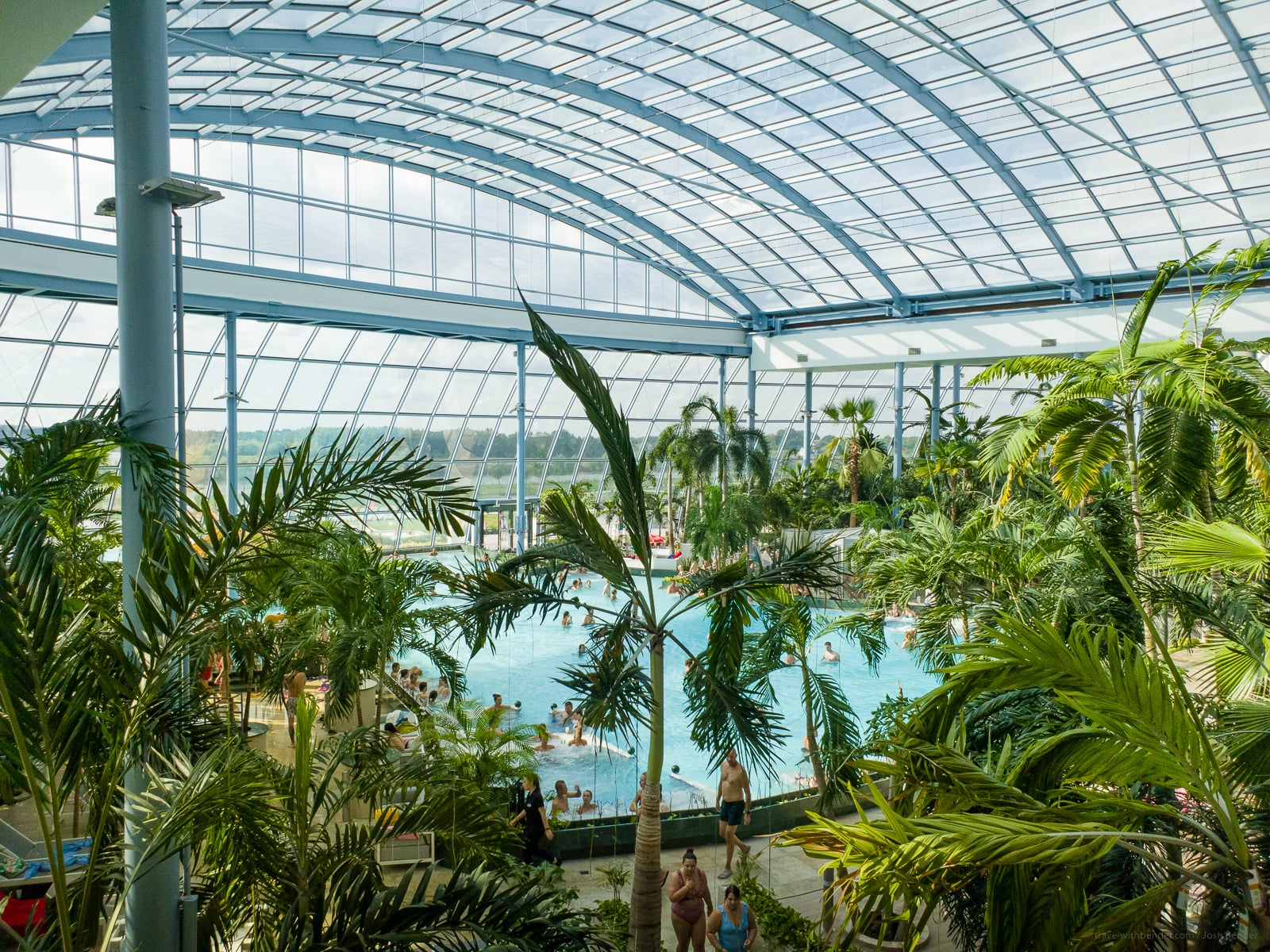
Essential Food to Try in Warsaw
Warsaw is a cosmopolitan city, fusing diverse food influences from all over the globe. Unfortunately, as a vegan, I found it difficult to track down authentic Polish cuisine that was plant-based too (with the exception of pierogi). So if you’re a meat eater, check out this list of essential foods to try in Warsaw.
However, the vegan food scene in Warsaw is buzzing. You can find all styles of cuisine, from Italian to Arabic to sushi. Here are the vegan-friendly eateries I can recommend:
eter (bakery), Peaches Gastro Girls (international), Uapami Seitan Burger (burgers/fast food), Vegan Sushi Bar (sushi), and Boca Boca - Vegan Guilty Pleasure (global street food).

And if it’s your first time in Warsaw, you must try…
Pierogi (Polish Dumplings)
You can’t visit Warsaw without tasting Pierogi! These filled dumplings are made by wrapping dough without yeast around a savoury or sweet filling and then cooking it in boiling water. It’s also possible to find fried versions too. The most popular savoury fillings are potatoes, fried onions, sour cheese curds, ground meat, mushrooms and cabbage, while dessert pierogi are found with an assortment of berries and other fruit.
While you can find these all over Warsaw, I can recommend Zapiecek for a cosy setting combined with authentic ingredients.
Extra Tips for First-Time Visitors to Warsaw
It’s Old But New
Warsaw is old, being founded in 1280 AD by the dukes of Mazovia. However, some tourists are surprised to find that many major historical attractions of Warsaw are reconstructions – not originals. During World War II, after the 1944 Warsaw Uprising of the Polish Resistance, furious Nazi leaders decided to raze the city in retaliation. 80-90% of buildings were destroyed. Post-war reconstruction efforts focused on modernising the city, while historically significant structures such as The Royal Castle were faithfully rebuilt as replicas.

Brochures
Save a tree, and download digital tourism brochures and maps for free from the Warsaw Tourist Office website.
Language
Most Varsovians (residents of Warsaw) are well-educated and speak a moderate amount of English. Reading signs in Polish isn’t too hard once you learn a few basic rules. Pronouncing them is a different thing! Fortunately, most letters are based on Latin characters, and there are no silent letters (like in English and French). Still, as a sign of courtesy, it pays to learn a few basic phrases in Polish. Make sure you download offline translations in the Google Translate app. The “audio transcribe” tool is a game-changer.
Stay Connected
Pick up a SIM card (or eSIM), so you’re connected to the Internet – don’t rely on jumping between insecure public WiFi hotspots. Read my article for more info on eSIMs in Europe. I used a SIM from Holafly with unlimited data, to stay connected all over Europe. It was my saving grace in Warsaw.
Navigate Like A Pro
I strongly recommend the mobile app Citymapper (iOS, Android) rather than Google Maps for navigating the public transport network. The live arrival times help to avoid wasting time standing at a bus or metro stop, when you could be cruising the Vistula River or strolling through another museum.
Do Your Research
Polish history goes back centuries, and it has been invaded at least 200 times, so the backstory is complicated, to say the least. Still, in order to fully appreciate your first visit to Warsaw, spend a little time brushing up on Polish history. Check out these series, movies, and documentaries:
Movies/Documentaries: The Deluge, Hatred, Ghetto Uprising.
YouTube: The Struggles for Poland, Polish Transformation, and a YouTube video playlist of 6 vids.

Where to Stay in Warsaw
Warsaw is split into 18 districts, with the current borders drawn up in 2002. On your first visit to Warsaw, you should allow at least 5 days to see all the major attractions, although if you are on a tight timeframe like I was, you can still cram a lot into 3 days because getting around the city is much easier than other European capitals. The 3 most common areas for tourists to stay are:
Śródmieście (central) – fortunately, accommodation in Warsaw is relatively affordable, even in the city centre. So make your life easier, and stay close to the action. There are plenty of restaurants and nightlife options, and public transport stations are within walking distance. Within this district, the sub-district of Powiśle is located on the western river bank near Vistula Boulevards, and the Stare Miasto (often called Old Town) is the most central spot for historical sightseeing.

Praga Północ (east) – looking for something a bit different and hip? The east side of the Vistula River is home to Praga, which is divided into north and south. This is still very close to the main tourist attractions on the west side, but with a little more edginess to the cultural character and cheaper accommodation options. The metro line makes it easy to travel all over town.
Mokotów (south) – if you’re on a road trip and need a reliable parking space and prefer the more modern side of the city, then this is it. Abundant parks, nature reserves, and green spaces make this ideal for kids, and the longest bike paths in the city are well-suited for outdoor lovers. This is also the most densely populated part of Warsaw, with a wide range of accommodations from comfortable to luxurious.
That’s A Wrap!
This is everything you need to know to make your first visit to Warsaw absolutely perfect – from attractions to transport to accommodation.
I freely fell in love with Poland’s capital, and I am not the only one. A big congratulations to the city for winning the “Best European destination 2023” award. There was stiff competition from other contenders, but Warsaw came out on top.
Now it’s your turn to find out why more and more tourists are falling head over heels for Warsaw.
Just member to give yourself enough time.
Otherwise, you’ll be kicking yourself, like me.










































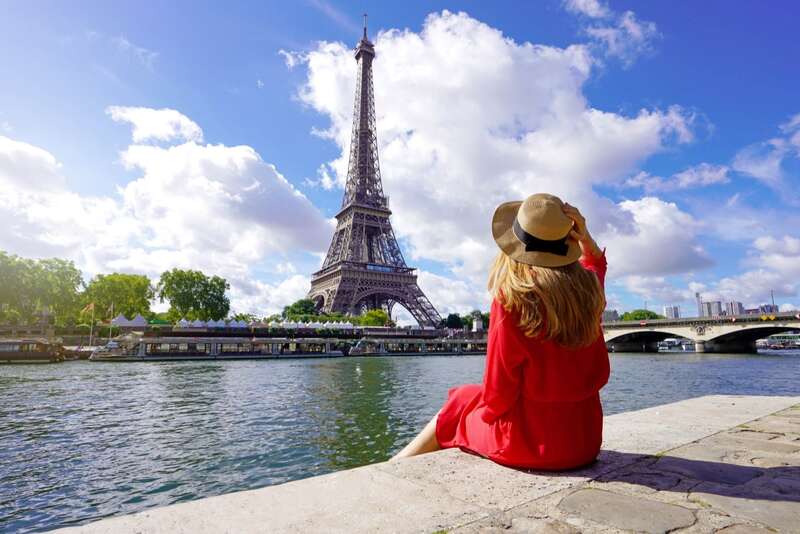

Write Your Comment
Please DO NOT include links, URLs or HTML in your comments - they will be automated deleted and you will waste your time.